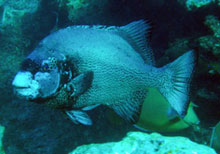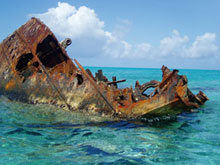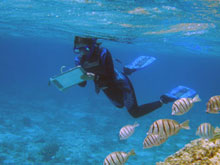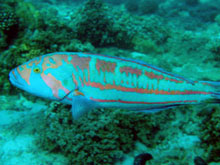|
Mission Log: June 29, 2006
Fish Comparisons between the Main Hawaiian Islands and the Northwestern Hawaiian Islands
Ellyn Tong, Hawai`i Audubon Society
 |
| A spotted knifejaw is a fish rarely seen in the Main Hawaiian Islands. (Photo: Claire Johnson/NOAA) |
REEF (Reef Environmental Education Foundation) fish surveys are conducted throughout the world. They are not the kind of surveys that governmental agencies usually use to create policy, however they are useful in that they can give a general idea of the relative abundance both over time and between places, of fish populations on coral reefs. Most governmental agencies simply do not have enough funding to pay scientific divers to survey all areas under their management. REEF surveys of the same area over time can alert governmental agencies of possible changes that may need attention, and subsequently these agencies my decide to conduct more quantitative surveys.
 |
| The wreck of the Hoei Maru in Kure Atoll was one of the target locations for the education team’s REEF fish counts. (Photo: Claire Johnson/NOAA) |
REEF gives the participant training in fish identification for their area and then the volunteer chooses a time, date and location to conduct the survey. The survey itself involves swimming (diving or snorkeling) in a random pattern, without going over areas already surveyed, while documenting fish species and their abundance.
Numerous REEF surveys have been logged in the Main Hawaiian Islands, one volunteer on Maui has logged over a hundred surveys alone. Few have been completed in the Northwestern Hawaiian Islands. Not every reef in the Northwestern Hawaiian Islands has been surveyed scientifically, and getting some idea of fish numbers may be helpful for comparison after, for example, a large storm event (like a hurricane) or a change in average temperature (climate change). It may also be useful for those doing surveys in the Main Hawaiian Islands to compare their findings to surveys conducted in the Northwestern Hawaiian Islands.
 |
| The NW Hawaiian Islands provide an abundance of fish species to count using REEF protocols. (Photo: Claire Johnson/NOAA) |
In comparison to the Main Hawaiian Islands, it is known that rarely seen fish and rare fish behaviors can be seen at Kure Atoll. On the mere four surveys we have conducted thus far, we have to our delight observed both fish rarely seen and experienced rare fish behaviors.
We saw both the barred knifejaws (Oplegnathus fasciatus) and spotted knifejaws (O. punctatus). According to Jack Randall’s book, Shore Fishes of Hawaii, these fish are rare in the Main Hawaiian Islands, though not uncommon in the Northwestern Hawaiian Islands. Knifejaws eat mollusks and barnacles, crushing their prey with strong, fused teeth. Their food may be more plentiful in the Northwestern Hawaiian Islands than the Main Hawaiian
Islands. Large species of barnacles are not common in the Main Hawaiian Islands, but we observed several molted barnacle exoskeletons floating in the water column in the same site we observed the knifejaws. This barnacle’s molted exoskeleton was at least one inch in diameter. According to Randal’s book, thicklipped jacks (Pseudocaranx dentex) are rare in the MHI, but we observed at least 50 schooling with yellow fin goatfish (Mulloidichthys vanicolensis) and yellowstripe goatfish (M. flavolineatus). Large schools of these two fish are rarely seen in the Main Hawaiian Islands, schooling with these fish may be a defensive strategy helpful to this species.
 |
| Surge wrasse exhibits territorial behavior, rarely seen in the Main Hawaiian Islands. (Photo: Claire Johnson/NOAA) |
Firsthand we experienced fish behavior rarely seen in the Main Hawaiian Islands. On one of Thursday’s surveys a male surge wrasse (Thalassoma purpureum) was exhibiting extremely aggressive territorial behavior. No other male surge wrasses were observed within a 50 yard radius of our first encounter with him, and he stayed with us, often around us or in our faces, until we exited his domain by getting into the boat. Few other large fishes were seen within this area, it could be guessed that any other intruders would be “har-wrassed” too. Seven other smaller, less colorful surge wrasses were observed, but they were all females, assumed to be part of his harem. Surge wrasses are delicious and this male’s in-your-face behavior in the human populated Main Hawaiian Islands would have made him, sadly enough, not long for this world. |



